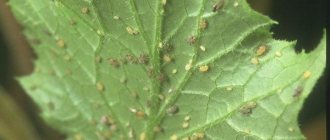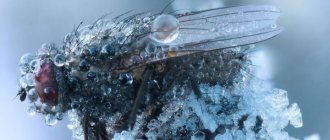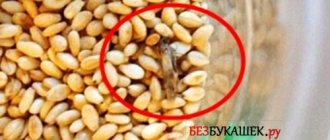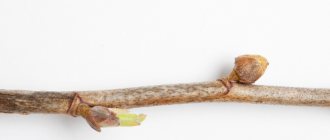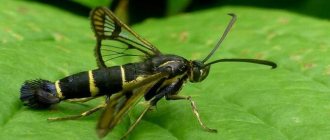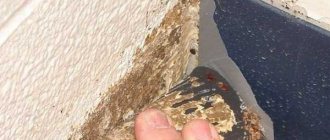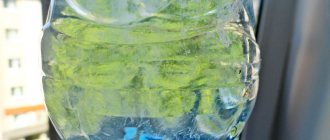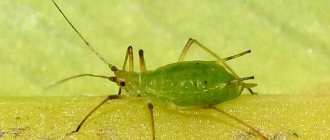Currant (currant) bud mite is the most dangerous pest of black currants. It can not only leave you without a harvest, but also cause weakening and death of plants. It is important to fight it in time and choose the right medications.
- Signs of plant damage by currant mite
- How dangerous are bud mites for plants?
- How to protect your garden from bud mites
- Measures to combat kidney mites
- Preparations against bud mites Spring treatments against bud mites
- Treatments against bud mite after harvest
Signs of appearance
You can detect the presence of a tick at different times of the year.
- In winter, the buds increase in size.
- In spring, the uneven development of the plant is noticeable. On shoots that are lagging in growth, the leaves are deformed and develop poorly. A mite-infested shrub has few flower stalks.
- In summer, due to curvature and underdevelopment of shoots, currants look sloppy. There are few ovaries; most fall off before reaching maturity. By the end of summer, damaged buds swell and begin to look very different from healthy ones.
- In autumn, increasing in size, the buds acquire a rounded shape.
Causes
From year to year, the number of spider mites is not the same, since their development and reproduction require certain conditions. The appearance of spider mites is due to the following reasons:
- Hot and dry weather. It is under such conditions that the mass birth of larvae occurs, which soon become adult insects. If cold snaps occur in the summer, the tick can easily wait them out.
- There is a lack of nutrients in the soil. Due to a lack of certain organic components and minerals in the soil, a general weakening of currant bushes occurs. Pests will definitely take advantage of this, since they primarily harm weakened plants.
- Infection of currants from other plants in the garden. If there is a plant infected with a mite next to a currant bush, after a short period of time the pest will move to a healthy bush.
- Dust settled on currant leaves. Heavily dusty plants are an excellent habitat for mites. In this regard, it is recommended to water currants weekly using the sprinkling method. Water will wash away dust from the sheet plates.
Description of the pest
Having carefully examined a photo of a bud mite enlarged several dozen times, you will notice that the currant parasite is a tiny worm.
Its body is less than half a millimeter long and 0.04 mm wide. It is impossible to see such a crumb with the naked eye. In March, the female lays eggs. She can lay about a hundred pieces at a time.
As soon as the first foliage appears, the mites crawl out and crawl through the bush. Most individuals die, and those that survive occupy healthy buds. Constantly reproducing, they parasitize the berry garden for 5 generations.
Pest removal methods
It is very difficult to fight the kidney mite because it is located inside the kidney. The larvae can be destroyed using pesticides during their movement. However, this is prohibited, as beneficial insects begin to pollinate the plants. Elimination of the parasite should be carried out before flowering, as well as after harvesting the berries.
The following methods of control are distinguished:
- preventive;
- industrial;
- folk
Prevention
Simple rules help prevent the appearance of pests:
- You need to buy seedlings in specialized stores and licensed nurseries;
- do not take cuttings from infected plants;
- in autumn and spring, carry out sanitary pruning, after which treat clothes, tools, and burn cut branches;
- keep the area clean.
Treatment with industrial preparations
How to deal with a bud pest if the currant is heavily damaged or its planting takes up a lot of space. It is useless to use insecticides, since the tick is an animal creature.
Effective in this case will be drugs that contain colloidal sulfur, as well as insectoacaricides, acaricides - “Oberon”, “Kintiks”, “Nitrophen”, “Aktellik”.
Chemicals must be used in accordance with the manufacturer's instructions. The plants are treated twice with an interval of 10-12 days; the dosage for repeated treatment is reduced by half.
To prepare a remedy for kidney mites, take 10 g of colloidal sulfur powder and dilute it in a liter of water. Spray currants before flowering and immediately after it. The mass of the substance during repeated treatment is 5 g. Spraying the bushes with a lime-sulfur solution follows the same scheme.
Colloidal sulfur must be used carefully, as plants can get burned.
Experts recommend such biological products as “Actofit”, “Fitoverm”, “Bitoxibacillin”. However, they give a positive effect only in the warm season, and the awakening of currants begins even at low temperatures.
It is necessary to begin treatment for a kidney mite during its movement from diseased kidneys to healthy ones. This period coincides with the appearance of flower stalks and lasts approximately 4 weeks.
Optimal development conditions
The bud mite begins to “wake up” when the air temperature steadily warms up to +5 C without frost. Intense sap flow enhances bud growth, increasing the feeding area for mites.
At +12 C their migration to other bushes begins, so during the spring season the currant mite can infect the entire garden. In the autumn, in warm regions until November, the insect migrates from eaten away bushes that are unsuitable for food. Closer to frost, it finds a whole plant and hides in the buds for wintering.
Traditional methods
When cold weather does not allow the use of bioacaricidal preparations to combat the bud pest or the degree of infection of the bush is low, folk remedies will come to the rescue. Common ones:
- manually picking off infected buds;
- pouring boiling water over;
- spraying with garlic infusion;
- treatment of currant cuttings before planting with a decoction of black tea leaves (40 g per 20 liters of water);
- watering with mustard solution;
- irrigation with infusion of dandelion, tobacco, walnut, onion peel;
- planting perennial onions next to a berry bush.
What to do, how to get rid of a bud mite that has infected a plant by 40% or more. Experts advise cutting branches to the ground. Of the newly appeared ones, leave the strong ones, remove the weak ones. You can expect a harvest next year.
Preventive measures
Prevention measures aimed at creating conditions unfavorable for ticks will become more effective and less costly.
To do this you need to follow some simple steps:
- from time to time destroy weeds on the site;
- collection and disposal of fallen leaves;
- use healthy planting material for propagation;
- increase the immunity of currants by applying fertilizers;
- digging up the soil around the bushes.
Start fighting ticks immediately after detecting traces of their presence. Delay and indecisiveness will lead to massive damage to bushes and loss of crops. Act methodically and consistently. By applying our recommendations, you can keep your currants healthy, even if ticks are rampant at your neighbors’ dacha.
Protect the environment
The fight against bud mites causes big problems for gardeners. However, proper care of currants and implementation of preventive measures can significantly reduce the possibility of crop loss. Most measures can protect crops from mites, harmful insects, and various diseases.
Do not forget that nature itself has invented a way to get rid of pests.
In the surrounding world, each parasite has its own natural enemies, entomophages, which successfully reduce its number. It is necessary to be attentive to small workers in gardens and vegetable gardens and to use chemicals carefully.
Insects that help fight mites are ladybirds, lacewings, carnivorous bugs, parasites (chalcids), hoverflies, encarsia wasps, phytoseiulus (predatory mites), etc.
Measures to combat currant mite
Not a single insectoacaricidal drug affects insect eggs. Therefore, treatments with poisons will be effective only during the period of hatching of the larvae.
The following are used as control measures:
- Chemicals.
- Folk, in the form of solutions.
- Biological products.
- Agrotechnical method.
As a biological control method, predator insects are used that destroy the currant mite.
Important! Mass migration of the parasite to new habitats occurs at the very peak of the growing season, when currants bloom or berries are set. At this time, intensive pollination of flowers by bumblebees, wasps, and bees occurs. The use of pesticides is prohibited.
